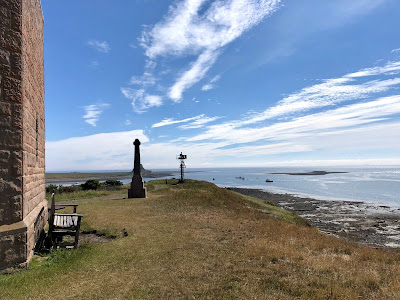On Day 3 we drove up to the Holy Island of Lindisfarne in plenty of sunshine! It was a tidal island. You can cross the causeway only during the safe crossing time, which changes daily and was between 9:40 and 16:20 on the day. We successfully passed the causeway around 9:40 by following a couple of cars to make sure it was safe!

First we visited Lindisfarne Priory ruins. It was AD 635 the monks arrived to the island at the first time. The monastery of Lindisfarne gained a reputation because of the miracles of St Cuthbert, a monk-bishop who joined the monastery in the 670s and was known as a pastor, seer and healer. His body was "incorrupt" in his coffin even after 11 years since his death in 689, which was believed as a sign of his purity and saintliness. However, the monks fled after Viking raiders attacked the monastery in 793. Eventually the monks came back with St Cuthbert’s relics to the island from Durham, escaping from the Norman Conquest. The ruins we saw was from the early 12th century.
Lindisfarne Castle was seen from the priory.
According to a tip from a gentleman who J chatted with at the priory, we climbed up to a small rocky hill between the priory and the shore. We got a great view of the both sides!
We walked toward Lindisfarne Castle. Unfortunately all the tickets to enter the castle for the day were sold out and we couldn't see the inside. It was originally a 16th century fort, which was built on a whinstone hill, the highest point of the island by using stones from the priory buildings after the priory was abandoned in the 16th century as part of the Dissolution of the Monasteries. In 1901, Edward Hudson, a business man and a founder of Country Life magazine bought the castle and had it largely refurbished in the Arts and Crafts style. Now it looked like it.
We walked more on the island, passing by old Lime Kilms, rocky beaches with many stone towers made of pebbles, and sheep!
There was a walled garden filled with various flowers and plants in the middle of wide plain grass filed. It was originally the garrison's vegetable plot, and now has been managed by National Trust. It was like a little oasis in dessert.
The Holy Island seemed very popular. There were many visitors! To avoid the crowd, we decided to go to Berwick-upon-Tweed for lunch. Berwick-upon-Tweed is the northernmost town in England. We were very close to Scotland!
We were going to have a lunch at a pub in the town that had received good reviews. On our way there, we just found an Italian restaurant and decided to try it instead. I had spaghetti with Napoli sauce again. Well, it was ok. J ordered a pizza. He said meh.
Probably the most famous attraction in the town would be Elizabethan Walls that were built to keep out the Scots and still remain well, which is said "the only example of bastioned town walls in Britain and one of the best preserved examples in Europe." We didn't have time to walk on the walls but saw a part of them. Berwick-upon-Tweed was a smaller town than I expected. There didn't seem to be a proper bakery to get sweets for tea as well as breads for breakfast. We managed to find a tearoom that offered some take-out baked goods. We bought two kinds cakes and two kinds of scones. Honestly they weren't good. Somehow we hadn't met a decent food yet as of Day 3.
To be continued...






















